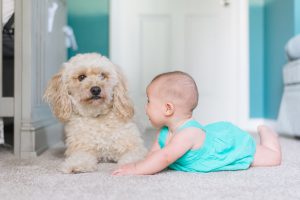Introducing your dog to your newborn baby can be a daunting task. Dogs can have a positive impact on children as they grow up, but they may be wary of a new baby at first. While dogs are familiar with humans, a human crawling on all fours is a different species to them. Further, this new tiny human is taking up all the owners’ time and attention. Contrary to what we as humans may think, dogs can and do feel jealousy. As any good dog owner knows, they are as much a part of the family as children, they deserve to be treated as such. Take the time to plan ahead during pregnancy to prepare your dog for the baby’s arrival. Enrolling in an obedience course is a great way to learn much-needed commands with your dog. Starting there will be useful in the future. Here are some tips to create a healthy relationship between your dog and child:
future. Here are some tips to create a healthy relationship between your dog and child:
1. Gradually Modify Your Dog’s Routine
A few weeks before the baby is due, start what will become your new routine. Go through everything you will have to do for the baby, at the times you’ll likely have to do it. This will ensure you and your dog know how he/she will fit into this routine. Maintain the same feeding times and walking times for your dog, but be sure to allow the dog time to become accustomed to the stroller alongside him/her. As difficult as it will be, work on lessening the amount of playtime with your dog as the due date gets closer. If you try to give your dog extra attention to make up for what s/he will lose, that will confuse them even more. It is important to ensure you can tend to the needs of your dog and your baby while also maintaining their respective schedules.
2. Acclimate Your Dog to Baby Scents
Once the baby is born, have someone bring home a blanket or clothing item with the baby’s scent. Allow your dog to become accustomed to it, as well as the scent of new diapers, wipes, and lotions.
3. Teach Basic Commands
Introducing the “go-to place” command will help keep your dog and baby separated when necessary. This “place” should be a safe, calm spot, such as a dog bed, a soft blanket, somewhere your dog would willingly go. Make sure to keep toys in that spot so your dog has something to do and associates that spot with something positive.
4. Greet Your Dog Alone Upon Arriving Home
When you get home from the hospital, greet your dog without the baby first, in case he/she is excited at first. This will keep your dog from jumping when you walk in with a baby in tow. Don’t immediately allow your dog to come in close contact with the new baby. Go about your routine for a couple of days to allow him/her to get used to the sights and smells. After a short period of time, calmly introduce them in closer proximity. It’s best to start this process with your dog on a leash to assess boundaries. You can normally move rather quickly to an off-leash interaction. Sudden kicking and screaming from the baby can spook a dog, so keep the baby elevated and in the arms of an adult throughout the process.
5. Make This a Positive Transition
Give your dog lots of attention when the baby is around. When the baby is safely in his/her swing or Pack-N-Play, engage your dog with baby insight. You don’t want the dog to think good things only happen when the baby isn’t around. Further, baby toys also happen to make great chew toys for your dog! Don’t punish your dog for picking up your child’s toy; instead, quickly replace it with a dog toy. Once the baby begins to crawl (and then walk), introduce boundaries to him/her. Show them the proper way to pet the dog and not to pull on its tail. Dogs can handle a bit of horseplay, but only when they are in the mood and if they are not getting hurt in the process. Don’t leave a child unattended with your dog, but do allow them time to play together in a safe and monitored environment.
6. Set Safe Boundaries
It’s a good idea to keep your dog out of your child’s room with a gate. You don’t want them in there unattended, and there could be small items or medicines that can make dogs sick. Further, close off rooms where you may allow the baby to engage in “tummy time” or learn to crawl. Dogs may see this as a time to play and could get a little rough. Similarly, space should be set aside strictly for your dog so he/she can go to a safe spot when feeling overwhelmed. Loud crying or a rowdy toddler could make a dog feel frightened, so there should be an area where the child can’t invade the dog’s space.
Practice safety with both your dog and your child, ensure they receive the proper care and attention, and you’ll have created a beautiful friendship!
Have Health Insurance Questions?
We hope that this information on introducing your pet to your newborn is helpful for you.
Insurance is oftentimes overwhelming and we want to shed light on the industry by answering your questions. Comment below and your question may be the topic of our next post!
If you liked this article, share it with your friends!
Empower Brokerage wants to help you find the insurance coverage you need and help you save money getting it. Stay on top of your health and give us a call at (844) 410-1320.
Get affordable health insurance quotes by clicking here.
See our other websites:

